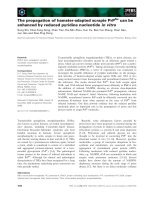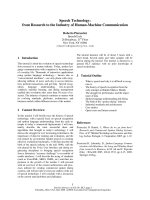Research report: "The propagation of ultrashort pulses Keer environment." doc
Bạn đang xem bản rút gọn của tài liệu. Xem và tải ngay bản đầy đủ của tài liệu tại đây (1.53 MB, 8 trang )
§¹i häc Vinh T¹p chÝ khoa häc, tËp XXXVI, sè 3A-2007
47
PROPAGATION EQUATION FOR
ULTRASHORT PULSES IN KERR MEDIUM
Dinh Xuan Khoa
(a)
, Nguyen Viet Hung
(b)
Abstract. In this article, we investigated propagation of ultrashort lase pulses in
the dispersive nonlinear medium. We showed the general propagation equation of
pulses which includes the linear and nonlinear effects to all orders. In the specific
case of Kerr medium, we obtained the ultrashort pulse propagation equation called
Generalized Nonlinear Schrodinger Equation. The impact of the third order
dispersion, the higher-order nonlinear terms self-steepening and stimulated Raman
scattering were explicitly analyzed.
I. INTRODUCTION
Theoretical and experimental research for propagation process of ultrashort
laser pulses (in fs) in a medium have been the subject of the intensive research in
the last few years [1, 3, 9, 12]. Because of special properties of these pulses, during
their propagation in the medium several new effects have been observed in
comparison with the propagation process of short pulses (in ps), namely the effects
of dispersion and nonlinear effects of higher orders. Under influence of these effects,
we have complicated changes both in amplitude and spectrum of the pulse. It splits
into constituents and its spectrum also evolves into several bands which are known
as optical shock and self-frequency shift phenomena [1, 3, 5]. These effects should be
studied in detail for the future concrete applications of ultrashort pulses, especially
in the domain of optical communication.
We apply the general formalism used for the pulse propagation problem in
for the one-dimensional case. This formalism is based on the approximate expansion
of the nonlinear wave equation, which treats the nonlinear processes involved in the
problem as the perturbations. In Sec. II we will present the theoretical model and
the basis of the method and derive from these considerations the general equation
for the pulse propagation process in the nonlinear dispersion medium with all orders
of the dispersion and nonlinearity. Using this formalism for the Kerr medium in
considering the delayed nonlinear response of the medium, induced by the
stimulated Raman scattering and the characteristic features both of the spectrum
and the intensity of the pulse, we will obtain an approximate equation in the most
condensed form, describing the propagation of the ultrashort pulses, called the
generalized nonlinear Schrodinger equation (GNLS). In Sec. III we derive a
normalized form of this equation and demonstrate its general features. We will
analyze in detail the influence of the third-order dispersion (TOD), the self-
steepening and the self-shift frequency for the ultrashort pulses in some special
cases. Sec. IV contains conclusions.
NhËn bµi ngµy 11/7/2007. Söa ch÷a xong 17/8/2007.
§¹i häc Vinh T¹p chÝ khoa häc, tËp XXXVI, sè 3A-2007
48
II. PROPAGATION EQUATION FOR ULTRASHORT PULSES
2.1. General form of the pulse propagation equation in the nonlinear
dispersion medium
The Maxwell equations can be used to obtain the following nonlinear wave
equation for the electric field [1, 2, 4]
where:
(
)
trP
l
,
ρ
ρ
and
(
)
trP
nl
,
ρ
ρ
are respectively the linear and nonlinear polarization.
For the homogeneous isotropic medium the linear polarization vector of the
medium is expressed as follows
where ∗ denotes the convolution product displaying the causality: the response of
the medium in the time t is caused by the action of the electric field in all previous
times t’. The quantity χ(
1)
is the susceptibility of the medium. It is a scalar.
The nonlinear polarization vector is generally expressed as follows
where
(
)
(
)
n
n
tttttt −−− ,,,
21
Λ
χ
is the n-order nonlinear susceptibility. For
the homogeneous isotropic medium, because of the spatial inversion symmetry the
elements of the even-order nonlinear susceptibility
(
)
(
)
k
k
tttt
21
2
,, −− Λ
χ
disappear
[1, 2, 4]. In the expression (5) we have only the nonlinear polarizations of odd orders.
We consider in detail only the third-order nonlinear susceptibility (the Kerr
medium). Then the tensor χ
(3)
has 3
4
=81 elements, but only 21 of its elements are
different from zero and three are independent [1]. We have therefore
In the hierarchy of the magnitudes the nonlinear polarization is much
smaller than the electric field and the linear polarization
(
)
(
)
(
)
(
)
tzEtzPtzPtzP
nllnl
,,,,,
0
ρ
ρ
ρ
ρ
ε
<<<< , so it can be considered as a perturbation
and we have the approximate formula:
(
)
0,.
≈∇
tzE
ρ
. Substituting these results into
(1) we obtain the following scalar wave equation
§¹i häc Vinh T¹p chÝ khoa häc, tËp XXXVI, sè 3A-2007
49
Transforming the equation (6) to the Fourier space and using the properties
of the Fourier Transform concerning the convolution and the derivatives of
transformed functions we obtain the algebraic equation for the monochromatic part
ω of the pulse as follows
where
( )
( )
( )
ωχω
1
1 +=n
is the refractive index of the medium calculated at the
frequency
ω
. We can write this equation in another form
with the notation
as the wave number of the part ω in the medium. The sign - and + in the front of the
square root sign describe respectively the wave propagating in or oppositely to the
positive direction of the axis Oz. We are interested only in the propagation in the
positive direction, so we will consider only the equation in the second square
parenthesis.
Because
(
)
ω
,kP
nl
is the perturbation in the comparison with the field
(
)
ω
,kE
the nonlinear term in the square root is small and we can perform the Taylor
expansion for this term [7]
Because the frequencies ω of the monochromatic parts of the pulse
concentrate around the central frequency ω
0
, we change the variables ω → ω +ω
0
, k
→ k+ k
0
in the above equation and expand around ω0. It follows that
§¹i häc Vinh T¹p chÝ khoa häc, tËp XXXVI, sè 3A-2007
50
The notations
(
)
(
)
(
)
(
)
Λ
0000
";';";'
ωωωβωβ
nn
are first-order and second-order
derivatives of the respective functions, calculated at the value ω
0
.
For obtaining the pulse propagation function in the medium we should
perform the inverse Fourier Transform of the equation (10). It follows that
The quantities
are higher-order perturbations, F and F
-1
denote the Fourier and the inverse Fourier
Transforms.
Equation (11) with the concrete form for the nonlinear polarization (5) and
the initial condition for the input pulse permit us to consider the pulse evolution in
the propagation in the medium. It is the most general form for the one-dimensional
case because it contains all orders of the dispersion and the nonlinearity.
2.2. Nonlinear polarization of the medium. Raman response function
The nonlinear polarization of the medium is given by (5), where the property
of the medium is characterized by the quantity
(
)
(
)
321
3
,, tttttt
xxx
−−−
χ
. For the
picosecond pulses the nonlinear response of the medium can be considered as
instantaneous. In this case the nonlinear susceptibility can be written as follows [2,
3, 7]
Here χ
(3)
is a real constant of the order 10
-22
m/V
2
, and δ(t-ti) (i = 1, 2, 3) are
the Dirac functions.
When input pulses are shorter than 4-5 ps (tens or hundreds fs) the
assumption of the instantaneous response of the medium is no longer valid because
the time width of the pulses is comparable with the characteristic times of the
microscopic processes. Some additional terms describing the delayed response of the
medium should be included in the expression (13). This delayed response is related
§¹i häc Vinh T¹p chÝ khoa häc, tËp XXXVI, sè 3A-2007
51
to the reduced Raman scattering on the molecules of the medium [7, 10]. Using the
Lorentz atomic model in the adiabatic approximation [1, 7] we can present the
nonlinear susceptibility of the medium in the form [3, 7]
In the expression for the nonlinear susceptibility (14) we have two
contributions, one of the electron layer and one of the nuclei plus the crystal lattice.
The electron response is considered as instantaneous, the delayed response of the
nuclei and the lattice is characterized by the function h
R
(t) called the Raman
response function. It has the following form [2, 7]
The Raman response function satisfies the normalization
condition
( )
.1
0
=
∫
∞
dtth
R
The constants
1
,
τ
R
f
and
2
τ
depend on the medium. The
Fourier Transform of the h
R
(t) (called also the Raman response function, but at the
frequency ω) has the following form
The imaginary part of g(ω) is called the Raman amplification function [7,9,
10].
2.3. Generalized nonlinear Schrodinger equation
Substituting the expression (14) into (5), we obtain the following expression
for the nonlinear polarization
The physical properties of the medium do not depend on the choice of the beginning
of the time scale, so the second term in (17) can be rewritten in the form
Expanding to the first order of the square of the module of the envelope
under the integral sign in (18) and using the normalization condition for the
function h
R
(t) leads to the result
where T
R
is the characteristic time for the Raman scattering effect
§¹i häc Vinh T¹p chÝ khoa häc, tËp XXXVI, sè 3A-2007
52
From these results we can write the nonlinear polarization in the form
Substituting the expression for the nonlinear polarization (21) into (11), after
omitting the fast oscillating terms we obtain the following simplest approximate
pulse propagation equation
Expanding further the equation (23) and neglecting the high-order
derivatives of the nonlinear term we have
where
Using the new parameters and variables
where τ
0
and P
0
stand respectively for the time width and the maximal power in the
top of the envelope function, we can rewrite the equation (23) in the normalized
form
The equation (26) is the lowest-order approximate form when we consider the
higher-order dispersion and nonlinearity effects in the general propagation equation
(11). It is one of the most useful approximate forms describing the propagation
process of the ultrashort pulses, called the generalized nonlinear Schrodinger
§¹i häc Vinh T¹p chÝ khoa häc, tËp XXXVI, sè 3A-2007
53
equation [3, 5, 7]. Some general remarks concerning the application of this equation
will be given in the next Section.
III. IMPACT OF DISPERSION AND HIGHER-ORDER NONLINEAR
EFFECTS ON THE ULTRASHORT PULSES
The propagation equation for the ultrashort pulses (26) has a more
complicated form than the nonlinear Schrodinger equation describing the
propagation of the short pulses [1, 2, 4, 5] because it contains the higher-order
dispersive and nonlinear terms. The parameters characterizing these effects: δ
3
, S,
τ
R
govern respectively the effects of TOD, self-steepening and the self-shift
frequency. From the formulas (25) we see that when τ
0
decreases, i.e. the pulse is
shorter, the magnitude of these parameters increases, the higher-order effects
should be considered.
Under the influence of TOD both the pulse shape and spectrum change in a
complicated way. When the propagation distance is larger the oscillation of the
envelope function is stronger, creating a long trailing edge to the later time, and the
spectrum is broadened into two sides and splits to the several peaks [2, 5].
Self-steepening of the pulse leads to the formation of a steep front in the
trailing edge of the pulse, resembling the usual shock wave formation. This effect is
called the optical shock. The pulse becomes more asymmetric in the propagation and
its tail finally breaks up [1, 4, 5].
In the stimulated Raman scattering the Stokes process is more effective than
the anti-Stokes process [2]. This fact leads to the so-called self-shift frequency of the
pulse. As a result the spectrum is shifted down to the low-frequency region. In other
words, the medium "amplifies" the long wavelength parts of the pulse. The pulse
losses its energy and changes complicatedly when it enters deeply into medium.
For the ultrashort pulses with the width
fs50
0
≈
τ
and the carrier wavelength
m
µλ
55.1
0
≈
, the higher-order parameters in (25) during their propagation in the
medium SiO
2
have the values
.1.0,03.0,03.0
3
=≈≈
R
S
τδ
These values are smaller
than one, so the higher-order effects are considered as the perturbations in
comparison with the Kerr effect. Therefore when the pulse propagates in a silica
optical fiber, the self-shift frequency effect dominates over the TOD and the self-
steepening for the pulses with the width of hundreds and tens femtoseconds. The
self-steepening becomes important only for the pulses of nearly 3 fs [2, 5].
When τ
0
has the value of picoseconds or larger, the values of δ
3
, S and τR are
very small and they can be neglected. The equation (26) reduces to the well-known
NLS equation for the short pulses [1, 2, 4].
IV. CONCLUSIONS
In this paper we derived the generalized nonlinear Schrodinger (GNLS)
equation for the propagation process of the ultrashort pulses in the Kerr medium.
The influence of the higher-order dispersive and nonlinear effects, especially the
nonlinear effect induced by the stimulated Raman scattering, have been considered
in detail.
Đại học Vinh Tạp chí khoa học, tập XXXVI, số 3A-2007
54
REFERENCES
[1] R. W. Boyd, Nonlinear Optics, Academic Press Inc., 2003.
[2] G. P. Agrawal, Nonlinear Fiber Optics, Academic, San Diego, 2003.
[3] U. Bandelow, A. Demircan and M. Kesting, Simulation of Pulse Propagation in
Nonlinear Optical Fibers, WIAS, 2003.
[4] Cao Long Van, Dinh Xuan Khoa, Marek Trippenbach, Introduction to Nonlinear
Optics, Vinh, 2003.
[5] Y. S. Kivshar, G. P. Agrawal, Optical Solitons: From Fibers to Photonic Crystals,
Academic Press, San Diego, 2003.
[6] Cao Long Van, Marek Trippenbach, Dinh Xuan Khoa, Nguyen Viet Hung, Phan
Xuan Anh, New solitary wave solutions of the higher order nonlinear
Schrodinger equation for the propagation of short light pulses in an optical fiber,
Journal of Science, Vinh University, XXXII, 1A (2003), 50-57.
[7] J. H. B. Nijhof, H. A. Ferwerda and B. J. Hoenders, Pure Appl. Opt., Vol.4 (1994),
pp. 199-218.
[8] R. H. Stolen and W. J. Tomlinson, J. Opt. Soc. Am. B., Vol.6 (1992), pp. 565-573, .
[9] R. H. Stolen, J. P. Gordon, W. J. Tomlinson, and H. A. Haus J. Opt. Soc. Am. B.,
Vol. 6 (1989), pp. 1159-1166.
[10] C. Headley III and G. P. Agrawal, J. Opt. Soc. Am. B., Vol.13 (1996), pp. 2170-
2177.
Tóm tắt
Phơng trình lan truyền xung cực ngắn
trong môi trờng keer
Trong bài này, chúng tôi đã khảo sát sự lan truyền xung cực ngắn trong môi
trờng tán sắc phi tuyến. Đã chỉ ra phơng trình lan truyền tổng quát bao gồm tất
cả các hiệu ứng tuyến tính và phi tuyến bậc cao. Trong trờng hợp đặc biệt, khi môi
trờng lan truyền là môi trờng Keer, chúng tôi đã thu đợc phơng trình lan
truyền xung gọi là phơng trình Schrodinger phi tuyến tổng quát. ảnh hởng của
tán sắc bậc ba của các số hạng phi tuyến bậc cao, của hiệu ứng tự dựng và hiệu ứng
tán xạ Raman cỡng bức đã đợc phân tích rõ.
(a)
trờng đại học vinh
(b)
NCS Tại viện hàn lâm khoa học Ba Lan.









